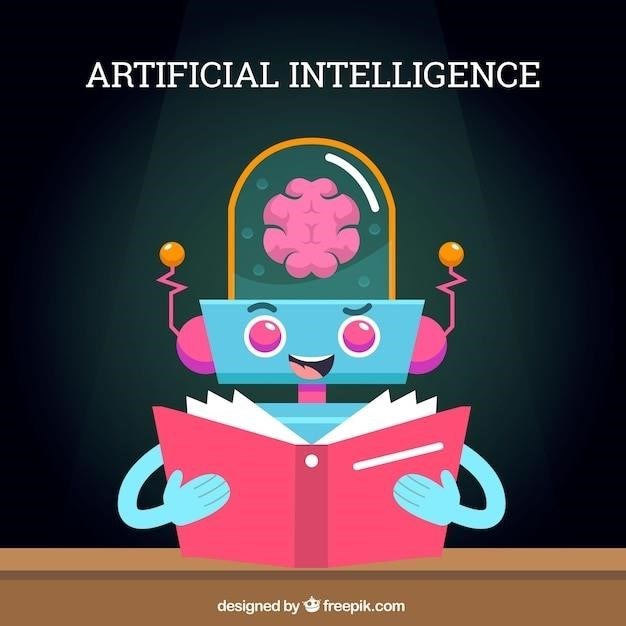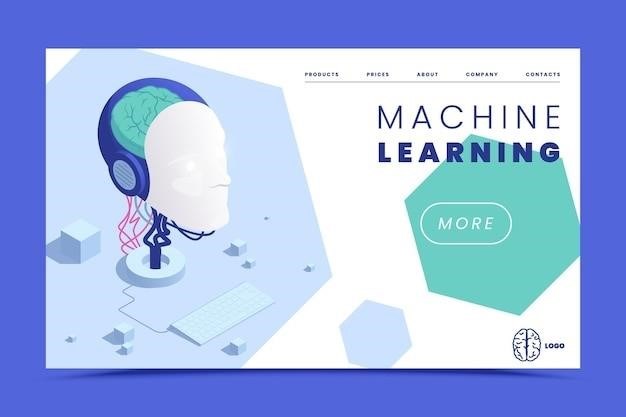Introduction to Machine Learning with PyTorch and Scikit-learn
This book comprehensively guides you through machine and deep learning using Python, PyTorch, and scikit-learn. It offers step-by-step tutorials and acts as a valuable reference.
What is Machine Learning?
Machine learning (ML) empowers computers to learn from data without explicit programming. Instead of relying on pre-defined rules, ML algorithms identify patterns, make predictions, and improve their accuracy over time based on the data they are exposed to. This involves training algorithms on datasets, allowing them to learn underlying relationships and generate models. These models are then used to make informed decisions or predictions on new, unseen data. ML techniques encompass various approaches, including supervised learning (using labeled data), unsupervised learning (using unlabeled data), and reinforcement learning (learning through trial and error). The choice of algorithm depends on the specific problem and the nature of the available data. PyTorch and scikit-learn provide robust tools to implement these algorithms effectively.
The Role of PyTorch in Deep Learning
PyTorch, a leading Python-based deep learning framework, plays a crucial role in building and training complex neural networks. Its dynamic computation graph allows for flexibility and ease of debugging, making it popular among researchers and developers. PyTorch’s intuitive API simplifies the implementation of various deep learning models, including convolutional neural networks (CNNs) for image processing, recurrent neural networks (RNNs) for sequential data, and transformers for natural language processing. The framework offers automatic differentiation, simplifying the calculation of gradients during the training process. Furthermore, PyTorch’s strong community support and extensive documentation facilitate learning and troubleshooting. Its integration with other Python libraries enhances its versatility in building end-to-end machine learning pipelines.
Scikit-learn for Traditional Machine Learning
Scikit-learn is a powerful Python library providing a comprehensive collection of efficient tools for various machine learning tasks. It excels in handling traditional machine learning algorithms, offering implementations of linear models, support vector machines (SVMs), decision trees, and ensemble methods like random forests and gradient boosting. Scikit-learn simplifies model selection, evaluation, and hyperparameter tuning through its user-friendly interface. Its emphasis on ease of use and clear documentation makes it ideal for both beginners and experienced practitioners. The library includes robust preprocessing tools for data cleaning, feature scaling, and dimensionality reduction, ensuring data readiness for optimal model performance. Scikit-learn’s focus on efficiency and scalability makes it suitable for a wide range of applications. Its extensive documentation and active community further enhance its appeal;

Key Features of the Book “Machine Learning with PyTorch and Scikit-learn”
This book provides a comprehensive guide to machine learning, detailed tutorials, and covers PyTorch, scikit-learn, and other relevant libraries.
Comprehensive Guide to Machine and Deep Learning
This book serves as a thorough guide to both machine learning and deep learning, bridging the gap between theoretical concepts and practical application. It doesn’t just skim the surface; it delves into the intricacies of each, providing readers with a solid understanding of the underlying principles. The comprehensive nature extends to its coverage of various algorithms and techniques, ensuring a well-rounded educational experience. From fundamental concepts to advanced topics, the book caters to a wide range of skill levels, making it suitable for both beginners and experienced practitioners looking to expand their knowledge. The depth of coverage allows readers to build a robust foundation in machine learning and deep learning, enabling them to tackle complex problems and develop sophisticated models with confidence. The detailed explanations make complex ideas accessible and easy to understand, fostering a deeper comprehension of the subject matter.
Step-by-Step Tutorials and Reference Material
The book seamlessly blends practical, step-by-step tutorials with comprehensive reference material. Each tutorial guides the reader through the implementation of specific machine learning and deep learning techniques using PyTorch and scikit-learn, providing hands-on experience. These tutorials are not merely code snippets; they offer detailed explanations of each step, ensuring understanding alongside execution. The accompanying reference material acts as a valuable resource, providing in-depth explanations of concepts, algorithms, and libraries. This dual approach allows for both immediate practical application and long-term knowledge retention. Readers can easily refer back to the reference sections to solidify their understanding of the underlying principles and refresh their memory on specific techniques. This combined structure makes the book an invaluable asset for both learning and future reference.
Coverage of PyTorch, Scikit-learn, and other relevant libraries
This resource provides extensive coverage of PyTorch and scikit-learn, two prominent Python libraries in the machine learning domain. PyTorch’s capabilities in deep learning are explored thoroughly, covering neural network architectures and training methodologies. Scikit-learn’s functionalities for traditional machine learning algorithms are also comprehensively detailed, enabling readers to build a strong foundation in both deep and classical machine learning techniques. Beyond these core libraries, the book integrates other relevant tools, such as those for data preprocessing, model evaluation, and visualization. This holistic approach ensures readers gain a well-rounded understanding of the entire machine learning workflow, from data preparation to model deployment. The inclusion of these supplementary libraries enhances the practical applicability of the presented concepts, empowering readers to tackle real-world machine learning problems effectively.

Practical Applications and Use Cases
Explore real-world applications like sentiment analysis, regression, and clustering, demonstrating practical uses of PyTorch and scikit-learn.
Sentiment Analysis
Sentiment analysis, a crucial natural language processing (NLP) task, involves determining the emotional tone behind a piece of text – whether it’s positive, negative, or neutral. This book delves into sentiment analysis techniques using both traditional machine learning approaches with scikit-learn and deep learning methods with PyTorch. You’ll learn how to preprocess text data, handle different types of sentiment, and evaluate the performance of your models. The practical examples show how to build effective sentiment analyzers for various applications, including social media monitoring, customer feedback analysis, and brand reputation management. Whether you’re using recurrent neural networks (RNNs) or simpler classifiers, the book equips you with the skills to create robust sentiment analysis systems that accurately gauge public opinion.
Regression Analysis
Regression analysis, a cornerstone of predictive modeling, focuses on understanding the relationship between a dependent variable and one or more independent variables. This section explores various regression techniques, from linear regression using scikit-learn’s straightforward implementations to more complex models. You will learn how to build and evaluate regression models, addressing challenges like overfitting and feature selection. The book covers both linear and non-linear regression methods, providing practical examples and insights into model interpretation. PyTorch’s capabilities are harnessed for implementing neural networks for regression tasks, enabling the prediction of continuous target variables with greater flexibility and accuracy than traditional methods. The book emphasizes practical application, guiding you through the process of building effective predictive models.
Clustering Analysis
This section delves into the world of unsupervised learning, specifically focusing on clustering techniques. You’ll discover how to group similar data points together without pre-defined labels, using algorithms like k-means and hierarchical clustering, readily available within scikit-learn. The practical application of these algorithms is explored through illustrative examples, demonstrating how to identify underlying patterns and structures within datasets. The book also covers advanced clustering methods and techniques for evaluating clustering performance. Understanding how to choose the optimal number of clusters and interpret the results is crucial, and this is thoroughly addressed. The chapter provides a solid foundation in unsupervised learning and its applications.
Authors and Their Expertise
The book boasts a team of renowned experts in machine learning, deep learning, and data science, each bringing unique skills and experience.
Sebastian Raschka
Sebastian Raschka, an Assistant Professor of Statistics at the University of Wisconsin-Madison, is a leading figure in machine learning and deep learning research. His expertise extends to various aspects of the field, including algorithm development, model deployment, and practical applications. Beyond academia, he serves as Lead AI Educator at Grid AI, demonstrating a commitment to fostering the growth of the AI community. His contributions to the field are evident in his widely acclaimed research papers and impactful books, solidifying his position as a key influencer in machine learning education and practice. He’s known for his clear and effective teaching style, making complex concepts accessible to a broad audience. His passion for machine learning is evident in his dedication to sharing knowledge and empowering others to succeed in this rapidly evolving field. Raschka’s influence extends to numerous online communities and educational resources, where he actively engages with learners and experts alike. His work continually pushes the boundaries of machine learning and contributes to the advancement of the field as a whole.
Yuxi (Hayden) Liu
Yuxi (Hayden) Liu, a highly accomplished machine learning expert, brings extensive experience from his time as a Machine Learning Software Engineer at Google. His career showcases a diverse range of applications, encompassing computational advertising, cybersecurity, and information retrieval. This broad experience highlights his adaptability and problem-solving skills within the dynamic field of machine learning. He is a prolific author, contributing to a series of influential machine learning books, including the widely successful “Python Machine Learning by Example,” which achieved #1 bestseller status on Amazon and has been translated into multiple languages. This demonstrates his ability to effectively communicate complex concepts to a large audience. Liu’s commitment to education is evident in his passion for sharing knowledge, making him a valuable asset to the machine learning community. His deep understanding of practical applications and theoretical foundations makes him a well-rounded and highly sought-after expert in the field.
Vahid Mirjalili
Vahid Mirjalili is a prominent figure in the field of deep learning, specializing in computer vision applications. His expertise stems from a strong academic background, holding a Ph.D. in both Mechanical Engineering and Computer Science from Michigan State University. This interdisciplinary approach provides a unique perspective, bridging the gap between engineering principles and computational methodologies. Mirjalili’s research likely focuses on developing and improving algorithms for analyzing and interpreting visual data, contributing to advancements in areas such as object recognition, image segmentation, and video analysis. His contributions to the book likely involve insights into the practical application of deep learning techniques within the computer vision domain, sharing his knowledge and experience to help readers effectively implement and interpret results. His expertise enhances the book’s value, offering readers a well-rounded understanding of deep learning’s practical applications.